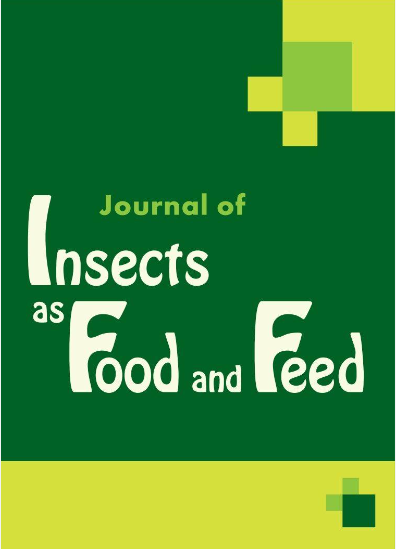肯尼亚西部的昆虫狩猎:消费模式以及心理和社会文化因素的作用
IF 3.5
3区 农林科学
Q1 ENTOMOLOGY
引用次数: 0
摘要
由于昆虫膳食(吃昆虫)具有作为蛋白质替代来源的潜力,因此受到了研究人员和发展行动者的极大关注。然而,尽管昆虫嗜食在肯尼亚西部等一些地区的接受度相对较高,但人们对推动昆虫嗜食的因素了解有限。因此,我们在肯尼亚西部的邦戈马县和外恩佐亚县进行了一项研究,利用随机抽样的 442 个家庭的数据分析昆虫消费模式和食虫行为的决定因素。分析采用了扩展的计划行为理论和结构方程模型来确定昆虫食性。白蚁、蚱蜢、蝗虫、蜣螂、蟋蟀和黑蚂蚁是这些社区食用的昆虫。白蚁是住户最熟悉和食用最多的昆虫。大多数家庭喜欢吃完整的昆虫,而不是加工过的昆虫。结果表明,态度(ATT)、感知行为控制(PBC)、社会规范和客观知识(OK)对家庭食用昆虫的意向有显著的积极影响,而环境问题和感知障碍(恐新症)则没有显著影响。在包括客观知识和环境问题的模型中,ATT 和 PBC 的影响较小。PBC 会降低 ATT 对行为意向的影响,同时直接对昆虫食性产生负面影响。进食意向与食虫行为呈正相关。除了这些心理因素外,我们还发现文化对昆虫食性有显著的解释作用。当我们对心理因素进行调节后,社会经济因素对昆虫食性没有任何影响。关于昆虫和文化的 ATT 和 OK 能显著预测对白蚁而非牛肉的偏好--这表明营养信息的积极作用。这些结果表明了心理变量和文化在影响昆虫食性方面的重要性。本文章由计算机程序翻译,如有差异,请以英文原文为准。
Entomophagy in western Kenya: consumption patterns and the role of psychological and socio-cultural factors
Owing to its potential as an alternative source of protein, entomophagy (insect eating) has received substantial attention from researchers and development actors. However, despite its relatively high acceptance in some regions, such as western Kenya, there is a limited understanding of the factors that drive entomophagy. Therefore, we conducted a study in western Kenya in Bungoma and Trans-Nzoia counties utilising data from a random sample of 442 households to analyse consumption patterns and determinants of insect-eating behaviour. The analysis used the extended theory of planned behaviour and structural equation modelling to determine entomophagy. Termites, grasshoppers, locusts, dung beetles, crickets, and black ants are examples of insects eaten by these communities. Termites are the most known and consumed insect among households. Most households prefer to eat the insects as a whole and not processed. Results indicate that attitude (ATT), perceived behavioural control (PBC), social norms and objective knowledge (OK) positively and significantly influence households’ intention to eat insects, whereas environmental concerns and perceived barriers (neophobia) have no significant effect. In the model where we include objective knowledge and environmental concern, the effects of ATT and PBC are lower. PBC reduces the effect of ATT on behavioural intention while directly negatively affecting entomophagy. Intention to eat is positively associated with insect-eating behaviour. In addition to these psychological factors, we found that culture significantly explains entomophagy. Once we condition on psychological factors, socioeconomic factors do not have any influence on entomophagy. ATT and OK about insects and culture significantly predict preference for termites over beef – suggesting the positive role of nutrition information. These results show the importance of psychological variables and culture in influencing entomophagy.
求助全文
通过发布文献求助,成功后即可免费获取论文全文。
去求助
来源期刊

Journal of Insects as Food and Feed
Agricultural and Biological Sciences-Insect Science
CiteScore
7.00
自引率
17.60%
发文量
133
期刊介绍:
The Journal of Insects as Food and Feed covers edible insects from harvesting in the wild through to industrial scale production. It publishes contributions to understanding the ecology and biology of edible insects and the factors that determine their abundance, the importance of food insects in people’s livelihoods, the value of ethno-entomological knowledge, and the role of technology transfer to assist people to utilise traditional knowledge to improve the value of insect foods in their lives. The journal aims to cover the whole chain of insect collecting or rearing to marketing edible insect products, including the development of sustainable technology, such as automation processes at affordable costs, detection, identification and mitigating of microbial contaminants, development of protocols for quality control, processing methodologies and how they affect digestibility and nutritional composition of insects, and the potential of insects to transform low value organic wastes into high protein products. At the end of the edible insect food or feed chain, marketing issues, consumer acceptance, regulation and legislation pose new research challenges. Food safety and legislation are intimately related. Consumer attitude is strongly dependent on the perceived safety. Microbial safety, toxicity due to chemical contaminants, and allergies are important issues in safety of insects as food and feed. Innovative contributions that address the multitude of aspects relevant for the utilisation of insects in increasing food and feed quality, safety and security are welcomed.
 求助内容:
求助内容: 应助结果提醒方式:
应助结果提醒方式:


